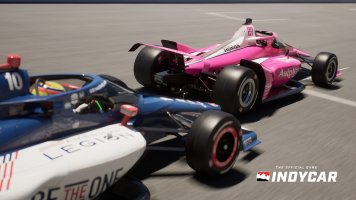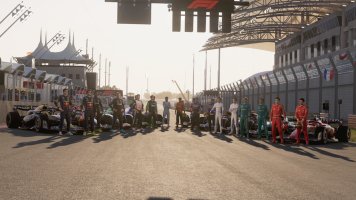I'm messing with shaders a bit right now.
Right now I am looking specifically at adding control for specular to the existing reflect shader... on Deyan's Murcielago the unified wheel/tyre texturing poses some problems.
I have to control reflection strength with an alpha map, so use the old trick of adding a syntax in the reflection shader so if we define reflection = -1, the baseCol.a is used to control reflection strength.
ambientColor=FresnelMix(ambientColor,envColor.rgb,(Kr>0?Kr:-Kr*baseCol.a),fresnel);
The problem now is that I have no spare texture slot for specular/shininess control.
So I have added this little fragment of code (from the bump speca shader)
Ks=baseCol*Ks;
This now allows the colouring of the outside of the tyre in the diffuse (rgb) channels, to do some work.
However, because the tyre is still dark in the diffuse texture (near black as it is a tyre), it doesn't have much effect on it's own.
I need to somehow increase the brightness of the texture so Racer pumps up the specular we see.
So I added a *5 multiplier to the Ks as you can see in the image attached.

Now what I don't understand is why the two images look different.
First case:
Ks in car.shd is 8, while Ks = baseCol * Ks * 5 essentially gives us Ks = baseCol * 40
Second case:
Ks in car.shd is 40, while Ks = baseCol * Ks essentially gives us Ks = baseCol * 40
Now, I don't get why they look different. Ks is meant to control the size of the specular too, but in either case they both calculate out to a peak shininess of 40, because the baseCol lookup isn't changing.
The specular settings remain the same.
It appears that multiplying by 5 in the shader means the specular level is pumped up 5x, while the shininess (size of the specular) is retained at 8 in the car.shd...
That is the effect I wanted to achieve, pumping up the actual output of the specular blob, while keeping it soft at a value of 8, but it seems un-intuitive/wrong because the value that really needs bumping up is the specular value, not shininess? (though the specular being multiplied by 5x (2.5 2.5 2.5) looked awful)
Am I missing something obvious here?
Ideally I'd like to control reflection amount, specular AND shininess using one shader here...
Probably using rgb.a for diffuse.reflection strength, and then another 3 channel texture for spec/shine and leaving another slot free for something else (perhaps transparrency?)
Specular/shininess maps add so much to these kinds of materials, so it is a shame that they haven't really been considered in the default shaders very much. I think they should almost be defaults in all materials that err away from being generally reflective (ie, using the envmap)
Bodging in the code I have for the Lambo works quite nicely in this case, but it's obviously not ideal to use the diffuse channel to control specular in this way.
Hmmmm
Dave
Right now I am looking specifically at adding control for specular to the existing reflect shader... on Deyan's Murcielago the unified wheel/tyre texturing poses some problems.
I have to control reflection strength with an alpha map, so use the old trick of adding a syntax in the reflection shader so if we define reflection = -1, the baseCol.a is used to control reflection strength.
ambientColor=FresnelMix(ambientColor,envColor.rgb,(Kr>0?Kr:-Kr*baseCol.a),fresnel);
The problem now is that I have no spare texture slot for specular/shininess control.
So I have added this little fragment of code (from the bump speca shader)
Ks=baseCol*Ks;
This now allows the colouring of the outside of the tyre in the diffuse (rgb) channels, to do some work.
However, because the tyre is still dark in the diffuse texture (near black as it is a tyre), it doesn't have much effect on it's own.
I need to somehow increase the brightness of the texture so Racer pumps up the specular we see.
So I added a *5 multiplier to the Ks as you can see in the image attached.

Now what I don't understand is why the two images look different.
First case:
Ks in car.shd is 8, while Ks = baseCol * Ks * 5 essentially gives us Ks = baseCol * 40
Second case:
Ks in car.shd is 40, while Ks = baseCol * Ks essentially gives us Ks = baseCol * 40
Now, I don't get why they look different. Ks is meant to control the size of the specular too, but in either case they both calculate out to a peak shininess of 40, because the baseCol lookup isn't changing.
The specular settings remain the same.
It appears that multiplying by 5 in the shader means the specular level is pumped up 5x, while the shininess (size of the specular) is retained at 8 in the car.shd...
That is the effect I wanted to achieve, pumping up the actual output of the specular blob, while keeping it soft at a value of 8, but it seems un-intuitive/wrong because the value that really needs bumping up is the specular value, not shininess? (though the specular being multiplied by 5x (2.5 2.5 2.5) looked awful)
Am I missing something obvious here?
Ideally I'd like to control reflection amount, specular AND shininess using one shader here...
Probably using rgb.a for diffuse.reflection strength, and then another 3 channel texture for spec/shine and leaving another slot free for something else (perhaps transparrency?)
Specular/shininess maps add so much to these kinds of materials, so it is a shame that they haven't really been considered in the default shaders very much. I think they should almost be defaults in all materials that err away from being generally reflective (ie, using the envmap)
Bodging in the code I have for the Lambo works quite nicely in this case, but it's obviously not ideal to use the diffuse channel to control specular in this way.
Hmmmm
Dave














